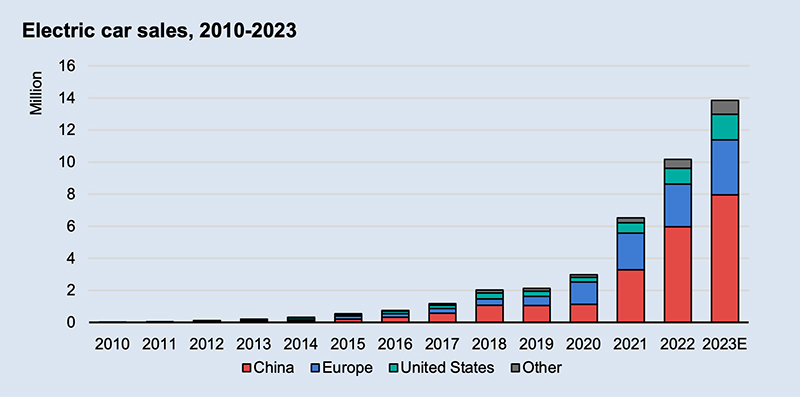Volcanoes are erupting in The Philippines, but on-fire Australia received some welcome rain. The Iran war cries have been called off and The Donald’s military powers are about to be hamstrung by the Senate. Meanwhile, his impeachment trial is starting, and we’re all on Twitter for a front-row seat.
What Could Go Right? The electric vehicles are coming!
Much faster than expected.
This is our weekly newsletter, What Could Go Right? Sign up here to receive it in your inbox every Thursday at 6am ET. You can read past issues here.
The electric vehicles are coming!
The electric vehicles (EVs) are coming! Much faster than expected.
The International Energy Agency (IEA)’s 2023 Global Electric Vehicle Outlook documents a swift uptick in EV sales, which include plug-in hybrids and battery-electric cars: three short years ago, in 2020, only 4 percent of new car sales were EVs. In 2022, 14 percent were. The IEA predicts that in 2023, 18 percent will be, and in 2030, 36 percent.

That may seem like small potatoes, but the exponential growth is the thing to pay attention to here. It took five years, from 2012 to 2017, for EV sales to go from 100,000 to one million. It took a mere five years more to go from one million to more than ten million.
There’s reason to believe that the IEA is even underestimating future EV growth, writes data scientist Hannah Ritchie on her Substack. Ritchie tracked IEA sales predictions from previous years and found that they are consistently lower than what has been borne out in reality. “Just last year,” she writes, the IEA “projected that in 2025, EVs would account for 13 percent of new car sales.” We have passed that percentage already, three years early. So it doesn’t seem unreasonable to imagine EV sales crossing majority market share globally in the not-too-distant future.
China, Europe, and the United States are the world’s three largest EV markets. But other markets in Asia, says the IEA report, are growing quickly, notably in India, Thailand, Singapore, and Indonesia.
Where EV sales already dominate, we can catch a glimpse at whether EVs are living up to promises. Last week The New York Times had a great piece on Norway, where 80 percent of new car sales are EVs. The result? Sharp declines in the yucky stuff, nitrogen oxides, that “cause smog, asthma, and other ailments”: check. Quieter streets: check. Falling emissions: check.
The two main issues Norway is facing are long lines at charging stations, since not enough have been installed, and unhealthy levels of microscopic particles that come in part from tires grinding on the roads—since EVs are heavier than combustion engine cars, they may be throwing up more particles.
The latter may be fixed by advancements that will make batteries lighter and lighter (so light that electric passenger aircraft may be a realistic possibility soon). And the former will certainly be fixed, with installation plans for stations underway in all EV markets, although of course at different speeds in different countries. (Large differences in station access exist even within Europe. Norway has around 20,000 stations, for example, whereas Europe’s leader, the Netherlands, has over 85,000. Here in Greece, where I live, the country only has 253, according to the app Electromaps. I was surprised and pleased, though, to find out that there are 5 or 6 even within walking distance of my apartment.)
As for the rest of the common concerns about EVs—Does the earth have enough rare minerals to make them en masse? (Yes) What about EV range capabilities? (Soon to be as good as a gas car)—economist and blogger Noah Smith addresses them here. My favorite point he makes is that most EV owners plug in their cars at home and let them charge overnight. Absent long trips, that means if you buy an EV, you can cross filling up your tank off your list of weekly errands forever.
I’m a big believer that portraying the clean energy transition as a sacrifice is mistaken. As newer, greener technology gets better and cheaper, our lives are likely to improve. The thought of a world in which I don’t have to go to gas stations anymore fills me with glee.
P.S. If you have more questions about EVs, The Progress Network (TPN)’s associate editor, Brian Leli, wrote this guide to EV FAQs last year.
Quick hits
Also from TPN this week: freaked out about the US being in default? Check out Jeremy Arnold’s debt ceiling explainer on how to understand coverage on it and why we shouldn’t panic. On the podcast, war correspondent Tim Mak joins us from Kyiv, Ukraine, for an update on the much-anticipated counteroffensive there, as well as some behind the scenes stories (like the time the only bomb shelter available had a polar bear in it).
And, an advisory panel for the Food and Drug Administration endorsed allowing birth control pills to be available over the counter for the first time in the US.
Below in the links section, reintroduced platypuses, cloned horses, accessible beaches, and more.
Secretly Sexy
A pop-up section in which we celebrate numbers that represent substantial improvement in people’s lives
2022: The year Indonesia eradicated nearly all extreme poverty (defined as living on less than $1.90 per day), two years ahead of their expected schedule
1.5: The percent of Indonesians living in extreme poverty, down from 19 percent in 2002
16: The percent of Indonesians living in poverty ($3.20 per day), down from 61 percent in 2002
(Source: The World Bank)

There is no debt ceiling crisis: an explainer

An evergreen guide to debt ceiling reporting and why this time is not in fact different | Read more
Ukraine’s Counteroffensive | S4 E14

What is the human side of war? Investigative journalist Tim Mak joins us from Kyiv to share an update on Ukraine’s spring counteroffensive, what life is like in a war-torn country, and what he has learned about resilience and mental health covering his first war. Plus, electric vehicles’ growth is explosive, and a battery breakthrough that could make electric passenger aircraft possible. | Listen to the episode
Progress, Please
(Found good news? Tweet at us @progressntwrk or email.)
Other good stuff in the news 🐴
Energy & Environment:
- Ecuador strikes a landmark deal to protect the Galápagos, and save cash | The New York Times
- In a historic first, Microsoft signs deal to buy fusion power by 2028 (see explainer) | The Hill
- Long popular in Asia, floating solar catches on in US | AP
- Deforestation in Brazil’s Amazon falls 68% in April | Reuters
- Wind is main source of UK electricity for first time | BBC
- Platypuses return to Sydney’s Royal National Park after disappearing for decades | ABC News
- Ukraine is planning its green reconstruction even as war rages on | Bloomberg
- Thailand ramps up shift to renewables | Bangkok Post
Public Health:
- First study of trends in cancer death rates by congressional district shows overall declines | American Cancer Society
- A skin patch to treat peanut allergies? Study in toddlers shows promise | AP
- Bangladesh eliminates lymphatic filariasis | WHO
- Lifesaving solution dramatically reduces severe bleeding after childbirth | WHO
- Research shows HIV/AIDS rate drop in Uganda, credits behavior change | The East African
- A surprising improvement in health coverage | YES! Magazine
- The radical drop in maternal mortality was a public health miracle | Big Think
- Pfizer RSV vaccine seen as effective against severe disease | Stat News
Science & Tech:
- Ground-breaking genetics library finally represents the whole of humanity | Inverse
- Pancreatic cancer vaccine shows promise in small trial | The New York Times
- A new cloned horse offers hope for endangered species | Wired
- AI is speeding up astronomy | Axios
- AI tool can predict pancreatic cancer up to three years in advance, says study | Metro
- American Heart Association certifies a plant-based ‘meat’ product for the first time | EcoWatch
Politics & Policy:
- Thai voters choose democracy in a stunning election | Vox
- Minnesota prepares for near-total ban on ‘forever chemicals’ | US News & World Report
- New blood donation rules allow more gay men to give in US | AP
- In Québec, a new traffic light only turns green for safe drivers | Streetsblog MASS
- Namibia recognizes same-sex marriages contracted abroad | Africanews
- Malawi’s Rastafarian children return to school after ban on dreadlocks is lifted | The Guardian
Society & Culture:
- ‘Glimmer of hope’ in African countries partially or fully abolishing death penalty | Africanews
- Greece makes nearly 200 beaches accessible with adaptive chairs | The Washington Post
Economy:
- Inflation slows for 10th straight month | The New York Times
- Workers are happier than they’ve been in decades | The Wall Street Journal
- IRS to offer free online tax prep for some taxpayers in 2024 | The Wall Street Journal
- The EU reduced carbon emissions while posting economic growth | Quartz
TPN Member originals 🧠
(Who are our Members? Get to know them.)
- Are things getting better or worse? | Emma Varvaloucas
- Is talking about democracy a good way to defend it? | Matthew Yglesias
- The second phase of the Biden presidency | David Brooks
- India’s strategy for growth and decarbonization | Jason Bordoff
- Machines of mind: The case for an AI-powered productivity boom | Erik Brynjolfsson
- The Covid pandemic: 13 takeaways for the next health emergency | Ezekiel J. Emanuel
- Kids who get smartphones earlier become adults with worse mental health | Jonathan Haidt
- The dubious MLK Jr. quote about Malcolm X | Peniel E. Joseph
- The Daniel Penny charges | Isaac Saul
- It’s time for Biden to out-Trump Trump on immigration | Thomas L. Friedman
Department of Ideas 💡
(A staff recommendation guaranteed to give your brain some food for thought.)
Chimp Empire | Netflix
Why we picked it: Look away from the culture wars, readers. Instead, fix your gaze on the fascinating (inter-)tribal politics and social hierarchies of our closest living relatives—chimps. As the docuseries’ narrator, actor Mahershala Ali, points out, “We can often recognize the best and worst of ourselves in them.” —Brian Leli
Until Next Time
A three-hour tour 29-day break from reality does sound nice. ⛵


